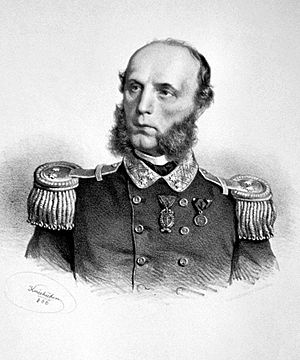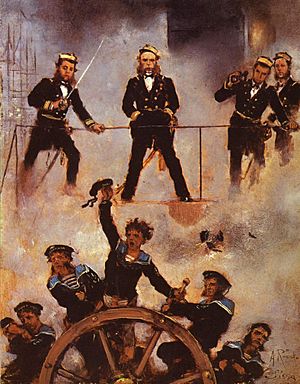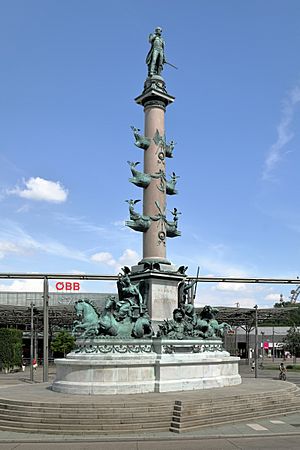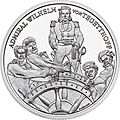Wilhelm von Tegetthoff facts for kids
Quick facts for kids
Wilhelm von Tegetthoff
|
|
|---|---|

Wilhelm von Tegetthoff, litography by Joseph Kriehuber, 1866
|
|
| Born | 23 December 1827 Maribor, Styria, Austrian Empire (now Maribor in Slovenia) |
| Died | 7 April 1871 (aged 43) Vienna, Austria-Hungary (modern Austria) |
| Allegiance | |
| Service/ |
|
| Years of service | 1840–1871 |
| Rank | Viceadmiral |
| Battles/wars | Second Schleswig War
|
Wilhelm von Tegetthoff (23 December 1827 – 7 April 1871) was an Austrian admiral. He led the navy during important battles, including the Second Schleswig War in 1864 and the Austro-Prussian War in 1866. Many historians in Austria believe he was one of the best naval officers of the 1800s. They remember him for his clever battle plans, strong leadership, and ability to inspire his sailors.
Contents
Wilhelm von Tegetthoff was born on December 23, 1827, in Maribor, which was then part of the Austrian Empire. Today, Maribor is in Slovenia. His father, Karl von Tegetthoff, was an officer in the Austrian Army.
In 1840, Tegetthoff joined the Marinecollegium, which was a naval academy in Venice. He became a junior officer, called a Seekadett, in 1845. He saw the Venetian uprising in 1848 and 1849. After graduating in 1849, he helped blockade Venice.
Tegetthoff quickly moved up in rank. He became a Fregattenleutnant in 1851 and a Linienschiffsleutnant in 1852. In 1854, he received his first command, the naval schooner Elisabeth. He strongly believed in using steam-powered ships, which were new at the time.
In 1855, he commanded the paddle steamer Taurus. He patrolled the Danube River during the Crimean War. This work caught the attention of Archduke Ferdinand Maximilian, who was the head of the Navy. Tegetthoff was promoted to Korvettenkapitän in 1857. He then went on a scientific trip to the Red Sea.
He showed great skill in diplomacy and organizing. In 1857, he became a staff officer. In 1858, he commanded the new ship Erzherzog Friedrich off the coast of Morocco.
Voyages and Squadron Command
In 1859, the Austrians could not challenge the French navy in the Adriatic Sea. After peace returned, Tegetthoff traveled with Ferdinand Maximilian to Brazil. They visited Emperor Pedro II in 1859 and 1860.
Tegetthoff continued to rise in rank. He became Fregattenkapitän in 1860 and Linienschiffskapitän in 1861. In 1862, he was put in charge of the Levant Squadron. In this role, he watched over the Greek revolution and problems in Syria.
Wilhelm von Tegetthoff is best known for his leadership in two major naval battles.
The Second Schleswig War: Battle of Heligoland
In February 1864, during the Second Schleswig War, Tegetthoff was given command of a small Austrian fleet. He sailed to the North Sea to help the weaker Prussian navy against the strong Danish navy. The Danish navy was blocking German ports.
Tegetthoff's fleet met a Danish fleet led by Edouard Suenson at the Battle of Heligoland. Tegetthoff's main ship, the Schwarzenberg, caught fire during a close fight with Danish ships. Even though his fleet took heavy damage, Tegetthoff achieved his goal. The Danish fleet was soon called back to Copenhagen, which ended the blockade of the Elbe and Weser ports.
After the battle, Emperor Franz Josef I promoted Tegetthoff to Kontreadmiral (Rear Admiral). He also gave him the Order of the Iron Crown.
The Seven Weeks' War: Battle of Lissa
Tegetthoff was made commander of the Austrian battle fleet on May 9, 1866. This was just before the Seven Weeks' War against Italy. The Italian fleet was larger and more powerful than the Austrian one. However, Tegetthoff decided to attack after scouting the Italian base at Ancona.
On July 16, 1866, the Italians sent their fleet to attack the Austrian naval base at Lissa. Lissa was off the coast of Dalmatia. On the morning of July 20, Tegetthoff found the Italian fleet. He sailed straight for the middle of their ships. He hoped to ram their ships because his own fleet did not have as much firepower. This tactic was called Rammstoßtaktik.
Smoke from the Italian ships made it hard to see. The Austrian ships missed the Italian fleet at first. Tegetthoff turned his ships around and charged again. This time, they set two Italian armored ships on fire and damaged several others.
Tegetthoff's main ship, the Erzherzog Ferdinand Max, rammed and sank the Italian armored frigate Re d'Italia. The Italian fleet then retreated the next day. Tegetthoff returned to his base at Pula in triumph.
Even though he won a great victory, it did not change the war's outcome much. Italy's alliance with Prussia meant they still got a good peace deal. Tegetthoff was immediately promoted to Vizeadmiral (Vice Admiral). He received many congratulations and was given the Commander's Cross of the Military Order of Maria Theresa. He was also made an honorary citizen of Vienna.
After the victory at Lissa, Tegetthoff suggested that Franz Josef should take control of the land behind the Dalmatian coast. This would help protect the naval bases there. This area, Bosnia and Herzegovina, was later occupied and annexed by Austria-Hungary, but long after Tegetthoff's death.
In 1866 and 1867, Tegetthoff traveled to France, Britain, and the United States to study their navies. After Ferdinand Maximilian was executed in Mexico, Tegetthoff was sent with the ship Novara to bring his body back to Austria. They arrived in Trieste on January 16, 1868.
Later Years and Legacy
In 1865, Tegetthoff became the Marinekommandant, the chief officer of the navy. In March 1868, he also took charge of the Naval Section of the War Ministry for the new dual monarchy of Austria-Hungary.
Despite some resistance, he worked hard to completely reform the Austro-Hungarian Navy. His changes stayed in place until the Austro-Hungarian Empire ended in 1918.
On April 1, 1868, Tegetthoff became a Geheimrat and a member of the Herrenhaus. Wilhelm von Tegetthoff died suddenly from pneumonia on April 7, 1871, in Vienna. He was only 43 years old. He is buried in the cemetery of St. Leonhard in Graz. Friedrich von Pöck took over as head of the naval administration after him.
Memorials and Honors
Many memorials honor Wilhelm von Tegetthoff. Statues were built in Maribor, Vienna, and Pula. The monument in Vienna, on Praterstern, is a tall column with a bronze statue of Tegetthoff on top. It was finished in 1886. The memorial in Pula was moved to Graz, Austria, in 1935.
Tegetthoff has also appeared on an Austrian postage stamp in 1935. In 2004, he was featured on a 20-euro coin.
Several ships were named after him:
- The arctic research ship SMS Tegetthoff (1872).
- The central battery ship SMS Tegetthoff (1878) – later renamed SMS Mars in 1912.
- The dreadnought battleship SMS Tegetthoff (1912).
The first ship, SMS Tegetthoff, was used in an arctic expedition from 1872 to 1874. During this trip, Julius von Payer and Karl Weyprecht discovered Franz Josef Land in 1873. Their first discovery there was named Cape Tegetthoff.
Images for kids
See also
 In Spanish: Wilhelm von Tegetthoff para niños
In Spanish: Wilhelm von Tegetthoff para niños
- Austro-Hungarian Navy – the navy after Austria and Hungary joined forces in 1867.
- SMS Tegetthoff (1912) – a powerful Austro-Hungarian battleship.
- Battle of Lissa – for more details on his most famous sea battle.
- The Serbian word for ultramarine blue, "teget," comes from Tegetthoff's name, based on the color of his uniform.




